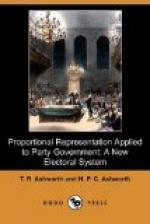A second reason why the wrong candidates are liable to be elected is that the process of elimination adopted by all the Hare methods has no mathematical justification. The candidate who is first excluded has one preference only taken account of, while others have many preferences given effect to. We have shown that this glaring injustice was recognized by Mr. Hare, and only adopted as a last resort. Professor Nanson admits that “the process of elimination which has been adopted by all the exponents of Hare’s system is not satisfactory,” and adds—“I do not know a scientific solution of the difficulty.” To bring home the inequity of the process, consider a party which nominates six candidates, A, B, C, D, E, and F, and whose numbers entitle it to three seats, and suppose the electors to vote in the proportions and order shown below on the first count.
FIRST SECOND THIRD FOURTH COUNT. COUNT. COUNT. COUNT. 7-vote ADEFBC ADEBC AEBC ABC 6-vote EFDACB EDACB EACB ACB 5-vote CEBDFA CEBDA CEBA CBA 4-vote BDFACE BDACE BACE BAC 4-vote DCEFBA DCEBA CEBA CBA 3-vote FBAECD BAECD BAEC BAC
It will be noted that F, having fewest first votes, is eliminated from the second count, D from the third count, and E from the fourth. A has then 13 votes, B 7, and C 9. If the quota be 9 votes, A’s surplus would be passed on to B, and A, B, and C would be declared elected. But D, E, and F are the candidates most in general favour, and ought to have been elected. For if any one of the rejected candidates be compared with any one of the successful candidates it will be found that in every case the rejected candidate is higher in order of favour on a majority of the papers. Again, if the Block Vote be applied, by counting three effective votes, the result would be—A 10 votes, B 12, C 9, D 21, E 22, and F 13. D, E, and F would therefore be elected. Thus we see that A, B, and C, the favourites of sections within the party, are elected, and D, E, and F, the candidates most in general favour—those who represent a compromise among the sections—are rejected.




